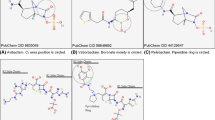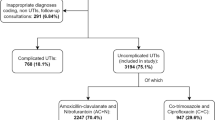Abstract
Symptomatic urinary tract infections (UTIs) are a major public health concern in the developed world, accounting for almost 8 million annual outpatient and emergency department visits in the US alone, while also representing one of the most common hospital-acquired infections. The vast majority of uncomplicated UTIs are caused by the Gram-negative bacillus Escherichia coli, with other pathogens including enterococci, Staphylococcus saprophyticus, Klebsiella spp. and Proteus mirabilis. Effective management of UTIs in both the inpatient and outpatient settings has been complicated by the fact that many uropathogenic strains have developed resistance to antimicrobials, including cotrimoxazole (trimethoprim/sulfamethoxazole), the current first-line treatment for uncomplicated UTIs in the US and many other countries. In some countries, other antimicrobial therapies, such as trimethoprim and nitrofurantoin, are also used for treatment of uncomplicated UTIs. Antimicrobial resistance has been associated with an increased rate of clinical failure, and reports from Canada and the US indicate that the prevalence of cotrimoxazole resistance exceeds 15% and can be as high as 25%.
The emergence and dissemination of antimicrobial resistance can be reduced with the use of agents that have favourable pharmacokinetic/pharmacodynamic profiles and convenient dose administration regimens that facilitate patient adherence and, therefore, pathogen eradication. Fluoroquinolones have been used successfully to treat a wide range of community- and hospital-acquired infections, and the rates of fluoroquinolone resistance have remained low. Use of fluoroquinolones is recommended for uncomplicated UTIs in areas where the incidence of cotrimoxazole resistance exceeds 10%, as well as for the treatment of complicated UTIs and acute pyelonephritis.
Ciprofloxacin is a widely used fluoroquinolone with high bactericidal activity against uropathogens and well established clinical efficacy in the treatment of UTIs. A new, extended-release formulation of ciprofloxacin (Cipro® XR) provides systemic drug exposure comparable with that achieved with twice-daily administration of conventional, immediate-release ciprofloxacin, while also attaining higher maximum plasma concentrations with less interpatient variability. Therapeutic drug concentrations with extended-release ciprofloxacin are established immediately after dose administration and maintained throughout the 24-hour dosage interval, permitting convenient, once-daily treatment. Clinical trial results confirm that extended-release ciprofloxacin is as safely used and effective as the conventional, immediate-release formulation of ciprofloxacin in patients with uncomplicated UTIs, complicated UTIs or acute uncomplicated pyelonephritis. These findings support the use of extended-release ciprofloxacin as a well tolerated, effective and convenient therapy for UTIs, which may improve patients’ adherence to therapy and, thereby, reduce the risk of infection recurrence and emergence of antimicrobial resistance.
Similar content being viewed by others
References
Warren JW, Abrutyn E, Hebel JR, et al. Guidelines for antimicrobial treatment of uncomplicated acute bacterial cystitis and acute pyelonephritis in women: Infectious Diseases Society of America (IDSA). Clin Infect Dis 1999 Oct; 29(4): 745–58
Foxman B. Epidemiology of urinary tract infections: incidence, morbidity, and economic costs. Am J Med 2002 Jul 8; 113 Suppl. 1A: 5S–13S
Gales AC, Jones RN, Gordon KA, et al. Activity and spectrum of 22 antimicrobial agents tested against urinary tract infection pathogens in hospitalized patients in Latin America: report from the second year of the SENTRY antimicrobial surveillance program (1998). J Antimicrob Chemother 2000 Mar; 45(3): 295–303
Urinary tract infections and the cost of antimicrobial resistance: a special report. In: Roberts WO, editor. Postgraduate medicine. Minneapolis (MN): Healthcare Information Programs, McGraw-Hill Healthcare Information Group, 2001 Aug
Marquie L, Raufaste E, Lauque D, et al. Pain rating by patients and physicians: evidence of systematic pain miscalibration. Pain 2003 Apr; 102(3): 289–96
Gordon KA, Jones RN. Susceptibility patterns of orally administered antimicrobials among urinary tract infection pathogens from hospitalized patients in North America: comparison report to Europe and Latin America. Results from the SENTRY Antimicrobial Surveillance Program (2000). Diagn Microbiol Infect Dis 2003 Apr; 45(4): 295–301
Karlowsky JA, Kelly LJ, Thornsberry C, et al. Trends in antimicrobial resistance among urinary tract infection isolates of Escherichia coli from female outpatients in the United States. Antimicrob Agents Chemother 2002 Aug; 46(8): 2540–5
Stratton C. Fluoroquinolone antibiotics: properties of the class and individual agents. Clin Ther 1992 May–Jun; 14(3): 348–75
Appelbaum PC, Hunter PA. The fluoroquinolone antibacterials: past, present and future perspectives. Int J Antimicrob Agents 2000 Sep; 16(1): 5–15
Naber KG, Bergman B, Bishop MC, et al. EAU guidelines for the management of urinary and male genital tract infections: Urinary Tract Infection (UTI) Working Group of the Health Care Office (HCO) of the European Association of Urology (EAU). Eur Urol 2001 Nov; 40(5): 576–88
Davis R, Markham A, Balfour JA. Ciprofloxacin: an updated review of its pharmacology, therapeutic efficacy and tolerability. Drugs 1996; 51(6): 1019–74
Karlowsky JA, Kelly LJ, Thornsberry C, et al. Susceptibility to fluoroquinolones among commonly isolated Gram-negative bacilli in 2000: TRUST and TSN data for the United States. Tracking Resistance in the United States Today. The Surveillance Network. Int J Antimicrob Agents 2002 Jan; 19(1): 21–31
Karlowsky JA, Thornsberry C, Jones ME, et al. Susceptibility of antimicrobial-resistant urinary Escherichia coli isolates to fluoroquinolones and nitrofurantoin. Clin Infect Dis 2003 Jan 15; 36(2): 183–7
Farrell DJ, Morrissey I, De Rubeis D, et al. A UK multicentre study of the antimicrobial susceptibility of bacterial pathogens causing urinary tract infection. J Infect 2003 Feb; 46(2): 94–100
Kahlmeter G. An international survey of the antimicrobial susceptibility of pathogens from uncomplicated urinary tract infections: the ECO.SENS Project. J Antimicrob Chemother 2003 Jan; 51(1): 69–76
Gupta K, Hooton TM, Stamm WE. Increasing antimicrobial resistance and the management of uncomplicated community-acquired urinary tract infections. Ann Intern Med 2001 Jul 3; 135(1): 41–50
Henry Jr DC, Bettis RB, Riffer E, et al. Comparison of once-daily extended-release ciprofloxacin and conventional twice-daily ciprofloxacin for the treatment of uncomplicated urinary tract infection in women. Clin Ther 2002 Dec; 24(12): 2088–104
Talan DA, Stamm WE, Hooton TM, et al. Comparison of ciprofloxacin (7 days) and trimethoprim-sulfamethoxazole (14 days) for acute uncomplicated pyelonephritis pyelonephritis in women: a randomized trial. JAMA 2000 Mar 22–29; 283(12): 1583–90
Ronald A. The etiology of urinary tract infection: traditional and emerging pathogens. Dis Mon 2003 Feb; 49(2): 71–82
Jones RN, Kugler KC, Pfaller MA, et al. Characteristics of pathogens causing urinary tract infections in hospitals in North America: results from the SENTRY Antimicrobial Surveillance Program, 1997. Diagn Microbiol Infect Dis 1999 Sep; 35(1): 55–63
Gupta K, Hooton TM, Wobbe CL, et al. The prevalence of antimicrobial resistance among uropathogens causing acute uncomplicated cystitis in young women. Int J Antimicrob Agents 1999 May; 11(3–4): 305–8
Gupta K, Scholes D, Stamm WE. Increasing prevalence of antimicrobial resistance among uropathogens causing acute uncomplicated cystitis in women. JAMA 1999 Feb 24; 281(8): 736–8
Nicolle LE. Urinary tract infection: traditional pharmacologic therapies. Am J Med 2002 Jul 8; 113 Suppl. 1A: 35S–44S
Zhanel GG, Karlowsky JA, Harding GK, et al. A Canadian national surveillance study of urinary tract isolates from outpatients: comparison of the activities of trimethoprim-sulfamethoxazole, ampicillin, mecillinam, nitrofurantoin, and ciprofloxacin. The Canadian Urinary Isolate Study Group. Antimicrob Agents Chemother 2000 Apr; 44(4): 1089–92
Data on file, Bayer Pharmaceutical, 2003
Gupta K, Sahm DF, Mayfield D, et al. Antimicrobial resistance among uropathogens that cause community-acquired urinary tract infections in women: a nationwide analysis. Clin Infect Dis 2001 Jul 1; 33(1): 89–94
Wright SW, Wrenn KD, Haynes ML. Trimethoprim-sulfamethoxazole resistance among urinary coliform isolates. J Gen Intern Med 1999 Oct; 14(10): 606–9
Steinke DT, Seaton RA, Phillips G, et al. Prior trimethoprim use and trimethoprim-resistant urinary tract infection: a nested case-control study with multivariate analysis for other risk factors. J Antimicrob Chemother 2001 Jun; 47(6): 781–7
Sahm DF, Thornsberry C, Kelly LJ, et al. In vitro activities of commonly used antibiotics against prevalent uropathogens: implications for empiric therapy. Infect Urol 2001; 14: 59–67
Masterton RG, Bochsler JA. High-dosage co-amoxiclav in a single dose versus 7 days of co-trimoxazole as treatment of uncomplicated lower urinary tract infection in women. J Antimicrob Chemother 1995 Jan; 35(1): 129–37
McCarty JM, Richard G, Huck W, et al. A randomized trial of short-course ciprofloxacin, ofloxacin, or trimethoprim/sulfamethoxazole for the treatment of acute urinary tract infection in women: Ciprofloxacin Urinary Tract Infection Group. Am J Med 1999 Mar; 106(3): 292–9
Raz R, Chazan B, Kennes Y, et al. Empiric use of trimethoprimsulfamethoxazole (TMP-SMX) in the treatment of women with uncomplicated urinary tract infections, in a geographical area with a high prevalence of TMP-SMX-resistant uropathogens. Clin Infect Dis 2002 May 1; 34(9): 1165–9
Lode H, Borner K, Koeppe P. Pharmacodynamics of fluoroquinolones. Clin Infect Dis 1998 Jul; 27(1): 33–9
Turnidge J. Pharmacokinetics and pharmacodynamics of fluoroquinolones. Drugs 1999; 58 Suppl. 2: 29–36
Harder S, Fuhr U, Beermann D, et al. Ciprofloxacin absorption in different regions of the human gastrointestinal tract: investigations with the hf-capsule. Br J Clin Pharmacol 1990 Jul; 30(1): 35–9
Cipro XR. prescribing information. West Haven (CT): Bayer Pharmaceuticals, 2003
Theil FP, Frede M, Stass H. Population pharmacokinetic characterization of the new Ciprofloxacin MR formulation with Ciprofloxacin IR [abstract]. Clin Microbiol Infect 2003; 9 Suppl. 1: 1228
Stass H, Nagelschmitz J, Brendel E, et al. The effect of food on the pharmacokinetics of a new ciprofloxacin once daily formulation for treatment of uncomplicated or complicated urinary tract infections [abstract no. 23; poster no. 23 presented at meeting of the American Federation for Medical Research; 2002 Apr 11–14; Baltimore (MD)]. J Investig Med 2002; 50(2): 154A
Stass H, Nagelschmitz J, Brendel E, et al. Pharmacokinetics of a new ciprofloxacin once daily formulation for the treatment of complicated urinary tract infections [abstract no. 25; poster no. 25 presented at meeting of the American Federation for Medical Research; 2002 Apr 11–14; Baltimore (MD)]. J Investig Med 2002; 50(2): 155A
Stass H, Nagelschmitz J, Brendel E, et al. Pharmacokinetic characterization of a new ciprofloxacin once daily formulation for treatment of uncomplicated urinary tract infections [abstract no. 24; poster no. 24 presented at meeting of the American Federation for Medical Research; 2002 Apr 11–14; Baltimore (MD)]. J Investig Med 2002; 50(2): 155A
Cipro prescribing information. West Haven (CT): Bayer Pharmaceuticals, 2003
Woodcock JM, Andrews JM, Boswell FJ, et al. In vitro activity of BAY 12-8039, a new fluoroquinolone. Antimicrob Agents Chemother 1997 Jan; 41(1): 101–6
Reeves DS, Bywater MJ, Holt HA, et al. ln-vitro studies with ciprofloxacin, a new 4-quinolone compound. J Antimicrob Chemother 1984 Apr; 13(4): 333–46
Meagher AK, Forrest A, Dalhoff A, et al. A novel PK/PD model for prediction of outcomes with an extended release formulation of ciprofloxacin [abstract no. A-1257]. Paper presented at Interscience Conference on Antimicrobial Agents and Chemotherapy; 2002 Sep 27–30; San Diego (CA)
Talan DA, Klimberg IW, Nicolle LE, et al. Once daily, extended release ciprofloxacin for complicated urinary tract infections and acute uncomplicated pyelonephritis. J Urol 2004 Feb; 171(2): 734–9
Bertino Jr J, Fish D. The safety profile of the fluoroquinolones. Clin Ther 2000 Jul; 22(7): 798–817
Owens Jr RC, Ambrose PG. Clinical use of the fluoroquinolones. Med Clin North Am 2000 Nov; 84(6): 1447–69
Author information
Authors and Affiliations
Rights and permissions
About this article
Cite this article
Blondeau, J.M. Current Issues in the Management of Urinary Tract Infections. CNS Drugs 64, 611–628 (2004). https://doi.org/10.2165/00003495-200464060-00004
Published:
Issue Date:
DOI: https://doi.org/10.2165/00003495-200464060-00004




